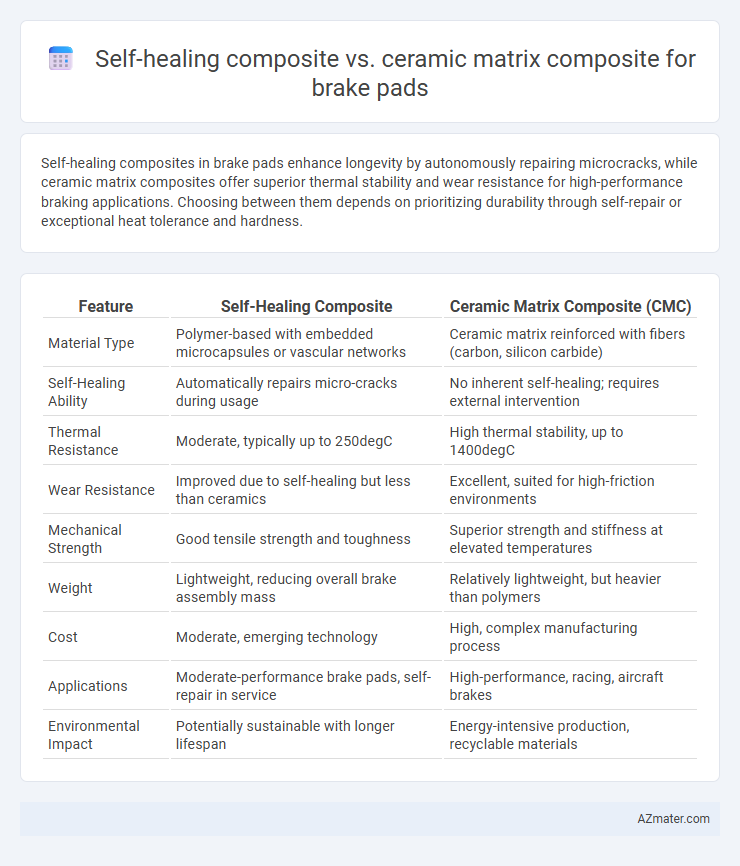Self-healing composites in brake pads enhance longevity by autonomously repairing microcracks, while ceramic matrix composites offer superior thermal stability and wear resistance for high-performance braking applications. Choosing between them depends on prioritizing durability through self-repair or exceptional heat tolerance and hardness.
Table of Comparison
| Feature | Self-Healing Composite | Ceramic Matrix Composite (CMC) |
|---|---|---|
| Material Type | Polymer-based with embedded microcapsules or vascular networks | Ceramic matrix reinforced with fibers (carbon, silicon carbide) |
| Self-Healing Ability | Automatically repairs micro-cracks during usage | No inherent self-healing; requires external intervention |
| Thermal Resistance | Moderate, typically up to 250degC | High thermal stability, up to 1400degC |
| Wear Resistance | Improved due to self-healing but less than ceramics | Excellent, suited for high-friction environments |
| Mechanical Strength | Good tensile strength and toughness | Superior strength and stiffness at elevated temperatures |
| Weight | Lightweight, reducing overall brake assembly mass | Relatively lightweight, but heavier than polymers |
| Cost | Moderate, emerging technology | High, complex manufacturing process |
| Applications | Moderate-performance brake pads, self-repair in service | High-performance, racing, aircraft brakes |
| Environmental Impact | Potentially sustainable with longer lifespan | Energy-intensive production, recyclable materials |
Introduction to Advanced Brake Pad Materials
Self-healing composites offer enhanced durability for brake pads by autonomously repairing micro-cracks, reducing maintenance frequency and extending service life. Ceramic matrix composites (CMCs) provide exceptional thermal stability and wear resistance, making them ideal for high-performance braking applications requiring consistent friction under extreme temperatures. Comparing both materials highlights the balance between self-repair capabilities and superior heat tolerance essential for advancing brake pad technology.
Overview of Self-Healing Composites in Automotive Industry
Self-healing composites in the automotive industry offer advanced damage recovery by autonomously repairing micro-cracks, enhancing brake pad longevity and safety. Compared to ceramic matrix composites, self-healing materials reduce maintenance costs and downtime with inherent crack-healing capabilities under thermal stress. These composites leverage embedded microcapsules or vascular networks filled with healing agents, making them highly attractive for high-performance automotive brake systems requiring durability and thermal stability.
Key Properties of Ceramic Matrix Composites
Ceramic Matrix Composites (CMCs) for brake pads exhibit exceptional thermal stability, maintaining structural integrity at temperatures exceeding 1200degC, which surpasses the limits of conventional self-healing composites. Their high resistance to wear and oxidation ensures prolonged lifespan and consistent friction performance under extreme braking conditions. Enhanced fracture toughness and low density contribute to reduced brake pad weight while providing superior mechanical strength and durability compared to traditional self-healing composites.
Performance Comparison: Self-Healing vs Ceramic Matrix Composites
Self-healing composites for brake pads offer enhanced durability by autonomously repairing microcracks, significantly extending service life under high-stress conditions. Ceramic matrix composites (CMCs) provide superior thermal resistance and wear performance, maintaining structural integrity at extreme temperatures typical in braking systems. While self-healing composites excel in mitigating damage accumulation, CMCs dominate in high-temperature stability and consistent frictional properties.
Durability and Lifespan in Brake Pad Applications
Self-healing composites in brake pads enhance durability by autonomously repairing microcracks, significantly extending lifespan compared to ceramic matrix composites (CMCs), which resist high temperatures but lack self-repair capabilities. Ceramic matrix composites offer superior thermal stability and wear resistance essential for high-performance braking systems, yet their lifespan is limited by crack propagation under cyclic stress. Self-healing composites outperform CMCs in durability by combining thermal tolerance with autonomous damage mitigation, resulting in prolonged service intervals and reduced maintenance costs.
Thermal Stability and Heat Resistance
Self-healing composites offer enhanced thermal stability and can autonomously repair microcracks, extending brake pad lifespan under high-temperature conditions. Ceramic matrix composites (CMCs) exhibit exceptional heat resistance withstanding temperatures up to 1600degC, but lack intrinsic self-healing properties. The integration of self-healing mechanisms in composites optimizes thermal durability while maintaining mechanical integrity, presenting a promising alternative to traditional CMC brake pads.
Wear Resistance and Friction Characteristics
Self-healing composites in brake pads exhibit superior wear resistance by autonomously repairing micro-cracks, extending service life and maintaining structural integrity under high stress. Ceramic matrix composites (CMCs), known for their high thermal stability and low wear rate, provide excellent friction characteristics with consistent performance across extreme temperatures. Compared to CMCs, self-healing composites offer enhanced durability and reduced maintenance costs through their intrinsic micro-crack healing ability, optimizing both wear resistance and friction stability.
Maintenance Requirements and Operational Costs
Self-healing composites in brake pads significantly reduce maintenance requirements by autonomously repairing micro-cracks, extending service life and minimizing downtime compared to ceramic matrix composites (CMCs), which require periodic inspections and repairs due to their brittle nature. The operational costs for self-healing composite brake pads are lower over time as they mitigate wear-related damages, whereas CMCs incur higher lifecycle expenses from frequent replacements and maintenance interventions. Enhanced durability and reduced maintenance translate to cost-effective performance advantages for self-healing composite materials in automotive braking systems.
Environmental Impact and Sustainability
Self-healing composites in brake pads reduce waste by extending service life and minimizing material consumption compared to ceramic matrix composites, which often require more intensive energy and resource inputs during manufacturing. The ability of self-healing composites to autonomously repair micro-cracks decreases replacement frequency, lowering the environmental footprint associated with production and disposal processes. Ceramic matrix composites, while offering high-temperature resistance, typically involve energy-intensive processing and less recyclability, making self-healing composites a more sustainable option for eco-friendly braking systems.
Future Trends in Brake Pad Material Technology
Self-healing composites in brake pads offer enhanced durability by autonomously repairing micro-cracks, reducing maintenance costs and improving safety compared to traditional materials. Ceramic matrix composites (CMCs) provide superior thermal stability and wear resistance, crucial for high-performance braking systems in electric and autonomous vehicles. Future trends indicate a hybrid approach combining self-healing polymers with ceramic matrices to optimize thermal management, mechanical strength, and longevity in next-generation brake pad technologies.

Infographic: Self-healing composite vs Ceramic matrix composite for Brake pad
 azmater.com
azmater.com